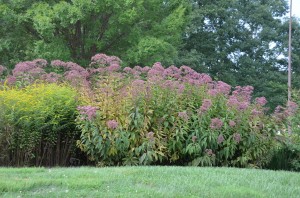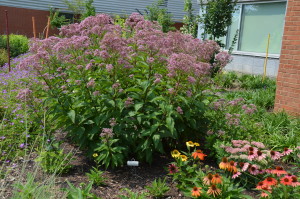U.S. native Joe Pye (Eupatorium spp.), formerly “Joe Pye Weed”, has been tamed. Modern day selections grow more compact compared to 8+ feet tall wildlings that inhabit fields across eastern North America (USDA hardiness zones 4-8). Huge, terminal, domed, compound flower heads measure 12-18 inches across (depending on cultivar) and make excellent cut flowers.
The most popular cultivar is ‘Gateway’ (E. purpureum ssp. maculatum ‘Gateway’) which produces magnificent domes of mauve pink flower clusters that sit atop sturdy purple stems. ‘Gateway’ typically stands 4-5 feet tall and erect in clumps and with dense thick inflorescences. Dark green 8-inch long lance-shaped leaves are coarsely-serrated and arranged in whorls of 3-4 on sturdy, wine-red stems.
Common Forms of Joe Pye:
Hollow stemmed Joe Pye (E. fistulosum) is a robust, upright perennial with hollow purple stems accented by huge, rounded, tight clusters of pink or purplish-mauve flowers.
‘Baby Joe’ Joe Pye (E. dubium) – mauve purple flowers appear on 3 to 4 foot tall plants from July to September (zones 3 to 9).
Joe Pye thrives in moist fertile soils along edges of ponds and streams. Plant is highly drought tolerant, although leaf edges often scorch in dry summers. It is disease and pest resistant and deer and rabbits stay away. Many kinds of butterflies, bees and other pollinators visit the florets. Seedheads persist well into winter and provide food for foraging birds. Keep poisonous leaves of Joe Pye away from grazing animals. Shortened cultivars are great stand-alone flowering perennials and serve as bold background plants.
Herbal folklore: Joe Pye (or Jopi) is named for a traveling Native American medicine man who lived in New England around the American Revolution era. He sold various herbal remedies to the colonists. Historically, Joe Pye weed was utilized to treat typhoid fever.



 Posted in
Posted in 
